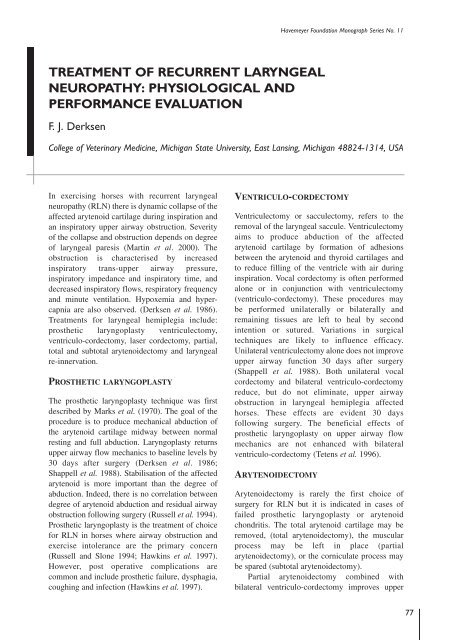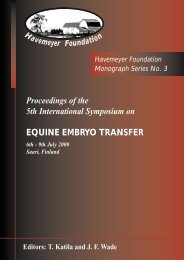Proceedings of a Workshop on - The Havemeyer Foundation
Proceedings of a Workshop on - The Havemeyer Foundation
Proceedings of a Workshop on - The Havemeyer Foundation
You also want an ePaper? Increase the reach of your titles
YUMPU automatically turns print PDFs into web optimized ePapers that Google loves.
<strong>Havemeyer</strong> Foundati<strong>on</strong> M<strong>on</strong>ograph Series No. 11<br />
TREATMENT OF RECURRENT LARYNGEAL<br />
NEUROPATHY: PHYSIOLOGICAL AND<br />
PERFORMANCE EVALUATION<br />
F. J. Derksen<br />
College <str<strong>on</strong>g>of</str<strong>on</strong>g> Veterinary Medicine, Michigan State University, East Lansing, Michigan 48824-1314, USA<br />
In exercising horses with recurrent laryngeal<br />
neuropathy (RLN) there is dynamic collapse <str<strong>on</strong>g>of</str<strong>on</strong>g> the<br />
affected arytenoid cartilage during inspirati<strong>on</strong> and<br />
an inspiratory upper airway obstructi<strong>on</strong>. Severity<br />
<str<strong>on</strong>g>of</str<strong>on</strong>g> the collapse and obstructi<strong>on</strong> depends <strong>on</strong> degree<br />
<str<strong>on</strong>g>of</str<strong>on</strong>g> laryngeal paresis (Martin et al. 2000). <strong>The</strong><br />
obstructi<strong>on</strong> is characterised by increased<br />
inspiratory trans-upper airway pressure,<br />
inspiratory impedance and inspiratory time, and<br />
decreased inspiratory flows, respiratory frequency<br />
and minute ventilati<strong>on</strong>. Hypoxemia and hypercapnia<br />
are also observed. (Derksen et al. 1986).<br />
Treatments for laryngeal hemiplegia include:<br />
prosthetic laryngoplasty ventriculectomy,<br />
ventriculo-cordectomy, laser cordectomy, partial,<br />
total and subtotal arytenoidectomy and laryngeal<br />
re-innervati<strong>on</strong>.<br />
PROSTHETIC LARYNGOPLASTY<br />
<strong>The</strong> prosthetic laryngoplasty technique was first<br />
described by Marks et al. (1970). <strong>The</strong> goal <str<strong>on</strong>g>of</str<strong>on</strong>g> the<br />
procedure is to produce mechanical abducti<strong>on</strong> <str<strong>on</strong>g>of</str<strong>on</strong>g><br />
the arytenoid cartilage midway between normal<br />
resting and full abducti<strong>on</strong>. Laryngoplasty returns<br />
upper airway flow mechanics to baseline levels by<br />
30 days after surgery (Derksen et al. 1986;<br />
Shappell et al. 1988). Stabilisati<strong>on</strong> <str<strong>on</strong>g>of</str<strong>on</strong>g> the affected<br />
arytenoid is more important than the degree <str<strong>on</strong>g>of</str<strong>on</strong>g><br />
abducti<strong>on</strong>. Indeed, there is no correlati<strong>on</strong> between<br />
degree <str<strong>on</strong>g>of</str<strong>on</strong>g> arytenoid abducti<strong>on</strong> and residual airway<br />
obstructi<strong>on</strong> following surgery (Russell et al. 1994).<br />
Prosthetic laryngoplasty is the treatment <str<strong>on</strong>g>of</str<strong>on</strong>g> choice<br />
for RLN in horses where airway obstructi<strong>on</strong> and<br />
exercise intolerance are the primary c<strong>on</strong>cern<br />
(Russell and Sl<strong>on</strong>e 1994; Hawkins et al. 1997).<br />
However, post operative complicati<strong>on</strong>s are<br />
comm<strong>on</strong> and include prosthetic failure, dysphagia,<br />
coughing and infecti<strong>on</strong> (Hawkins et al. 1997).<br />
VENTRICULO-CORDECTOMY<br />
Ventriculectomy or sacculectomy, refers to the<br />
removal <str<strong>on</strong>g>of</str<strong>on</strong>g> the laryngeal saccule. Ventriculectomy<br />
aims to produce abducti<strong>on</strong> <str<strong>on</strong>g>of</str<strong>on</strong>g> the affected<br />
arytenoid cartilage by formati<strong>on</strong> <str<strong>on</strong>g>of</str<strong>on</strong>g> adhesi<strong>on</strong>s<br />
between the arytenoid and thyroid cartilages and<br />
to reduce filling <str<strong>on</strong>g>of</str<strong>on</strong>g> the ventricle with air during<br />
inspirati<strong>on</strong>. Vocal cordectomy is <str<strong>on</strong>g>of</str<strong>on</strong>g>ten performed<br />
al<strong>on</strong>e or in c<strong>on</strong>juncti<strong>on</strong> with ventriculectomy<br />
(ventriculo-cordectomy). <strong>The</strong>se procedures may<br />
be performed unilaterally or bilaterally and<br />
remaining tissues are left to heal by sec<strong>on</strong>d<br />
intenti<strong>on</strong> or sutured. Variati<strong>on</strong>s in surgical<br />
techniques are likely to influence efficacy.<br />
Unilateral ventriculectomy al<strong>on</strong>e does not improve<br />
upper airway functi<strong>on</strong> 30 days after surgery<br />
(Shappell et al. 1988). Both unilateral vocal<br />
cordectomy and bilateral ventriculo-cordectomy<br />
reduce, but do not eliminate, upper airway<br />
obstructi<strong>on</strong> in laryngeal hemiplegia affected<br />
horses. <strong>The</strong>se effects are evident 30 days<br />
following surgery. <strong>The</strong> beneficial effects <str<strong>on</strong>g>of</str<strong>on</strong>g><br />
prosthetic laryngoplasty <strong>on</strong> upper airway flow<br />
mechanics are not enhanced with bilateral<br />
ventriculo-cordectomy (Tetens et al. 1996).<br />
ARYTENOIDECTOMY<br />
Arytenoidectomy is rarely the first choice <str<strong>on</strong>g>of</str<strong>on</strong>g><br />
surgery for RLN but it is indicated in cases <str<strong>on</strong>g>of</str<strong>on</strong>g><br />
failed prosthetic laryngoplasty or arytenoid<br />
ch<strong>on</strong>dritis. <strong>The</strong> total arytenoid cartilage may be<br />
removed, (total arytenoidectomy), the muscular<br />
process may be left in place (partial<br />
arytenoidectomy), or the corniculate process may<br />
be spared (subtotal arytenoidectomy).<br />
Partial arytenoidectomy combined with<br />
bilateral ventriculo-cordectomy improves upper<br />
77








